AI Camera Market Size 2025-2029
The AI camera market size is valued to increase by USD 19.01 billion, at a CAGR of 24.9% from 2024 to 2029. Proliferation of edge AI and advancements in semiconductor technology will drive the ai camera market.
Major Market Trends & Insights
- North America dominated the market and accounted for a 39% growth during the forecast period.
- By Product Type - Surveillance cameras segment was valued at USD 1.39 billion in 2023
- By Technology - Image and face recognition segment accounted for the largest market revenue share in 2023
Market Size & Forecast
- Market Opportunities: USD 671.41 million
- Market Future Opportunities: USD 19014.20 million
- CAGR from 2024 to 2029 : 24.9%
Market Summary
- The market is experiencing significant growth, with a projected value of USD15.6 billion by 2025. This expansion is driven by the proliferation of edge AI and advancements in semiconductor technology, enabling real-time processing and analysis of visual data. This trend is particularly relevant to the market, as it allows for more sophisticated image recognition and analysis capabilities. The integration of generative AI for natural language video interrogation further enhances the functionality of these devices, allowing for more sophisticated interactions and applications. However, navigating data privacy regulations and ethical concerns poses a challenge for market participants. As AI cameras become increasingly integrated into various industries, it is essential for companies to prioritize transparency and user consent to maintain trust and compliance.
- The future direction of the market lies in continued innovation and collaboration between technology developers and regulatory bodies to ensure responsible implementation and adoption.
What will be the Size of the AI Camera Market during the forecast period?
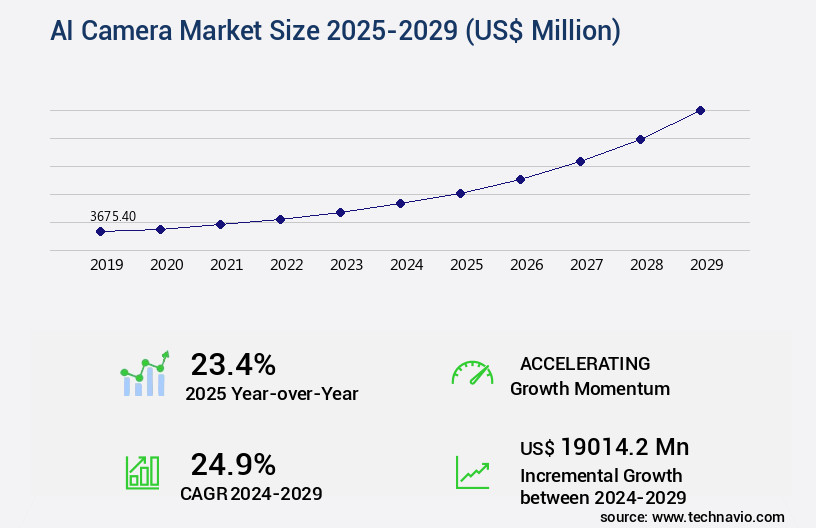
Get Key Insights on Market Forecast (PDF) Request Free Sample
How is the AI Camera Market Segmented ?
The AI camera industry research report provides comprehensive data (region-wise segment analysis), with forecasts and estimates in "USD million" for the period 2025-2029, as well as historical data from 2019-2023 for the following segments.
- Product Type
- Surveillance cameras
- Smartphone cameras
- DSLR cameras
- Others
- Technology
- Image and face recognition
- Computer vision
- Context awareness
- Voice and speech recognition
- Others
- End-user
- Consumer electronics
- Surveillance and public safety
- Automotive
- Retail
- Others
- Geography
- North America
- Europe
- APAC
- Australia
- China
- India
- Japan
- South Korea
- Rest of World (ROW)
By Product Type Insights
The surveillance cameras segment is estimated to witness significant growth during the forecast period.
In the dynamic and innovative the market, cutting-edge technologies continue to revolutionize the surveillance industry. Modern AI cameras employ advanced object tracking algorithms, pose estimation techniques, and image enhancement filters to ensure high-precision monitoring. Deep learning frameworks, such as convolutional neural networks and recurrent neural networks, power object detection models and image segmentation methods for real-time processing. These systems enable facial recognition systems, which can identify individuals with unprecedented accuracy. Thermal imaging cameras, sensor fusion techniques, and depth sensing technology further expand the capabilities of these devices. The integration of machine learning pipelines and hardware acceleration impact the market significantly, with computer vision algorithms like motion detection and visual slam systems enhancing situational awareness.
Moreover, the adoption of deep learning models for model inference latency reduction and real-time processing speed has become increasingly popular. Edge computing deployment, training dataset size, and lens distortion correction are essential considerations for optimizing AI model performance. Power efficiency metrics and camera calibration methods are also crucial factors in the development of this market. According to recent reports, The market is projected to grow at a compound annual growth rate of 21.5% between 2021 and 2028. This growth is driven by the increasing demand for advanced security and operational monitoring solutions, as well as the continuous advancements in AI and computer vision technologies.
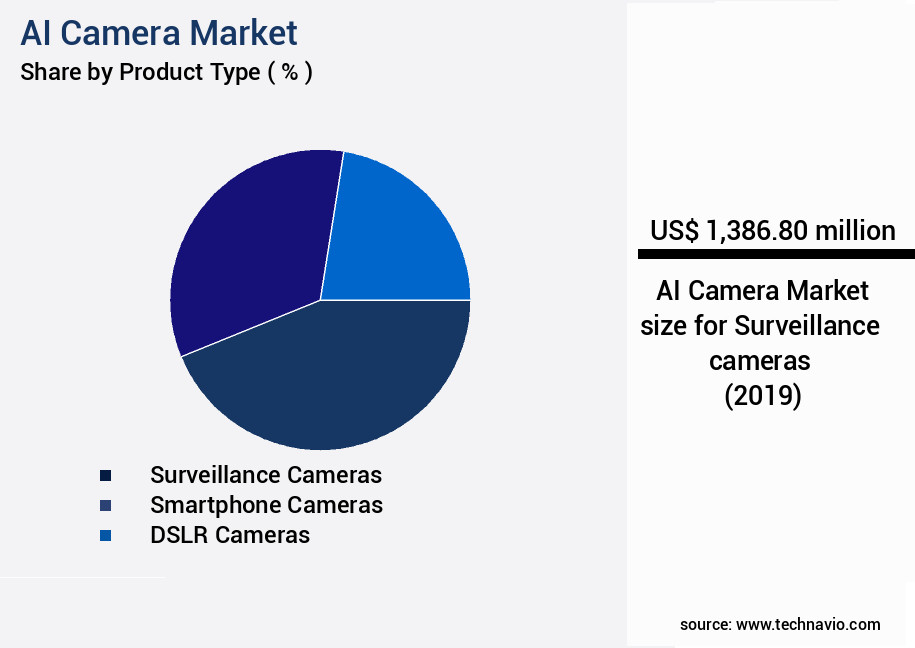
Request Free Sample
The Surveillance cameras segment was valued at USD 1.39 billion in 2019 and showed a gradual increase during the forecast period.
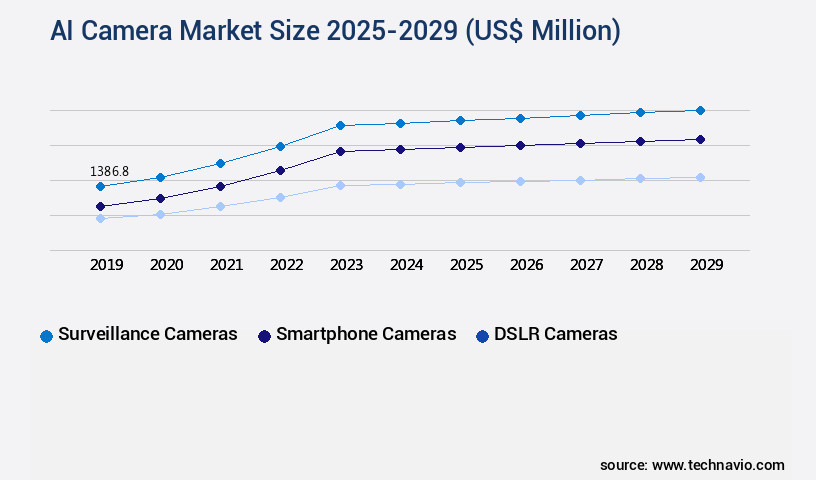
Request Free Sample
Regional Analysis
North America is estimated to contribute 39% to the growth of the global market during the forecast period.Technavio's analysts have elaborately explained the regional trends and drivers that shape the market during the forecast period.
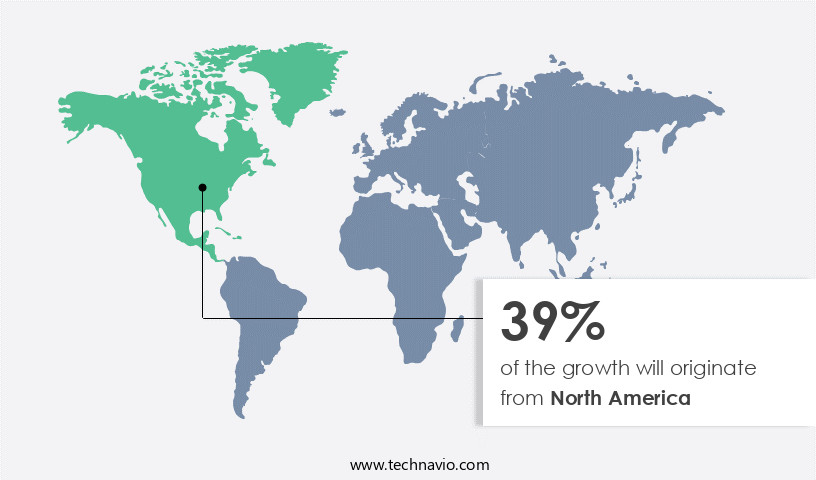
See How AI Camera Market Demand is Rising in North America Request Free Sample
The market is witnessing significant growth and transformation, with North America, specifically the United States and Canada, emerging as a key regional player. This region's advanced technological infrastructure, concentration of leading technology companies, and robust demand from both public and private sectors fuel market expansion. In the private sector, retailers, logistics companies, and large corporations are increasingly adopting AI cameras to enhance operational efficiency and bolster security. These end users employ sophisticated analytics for customer behavior analysis, inventory management, and ensuring workplace safety.
The retail sector, for instance, utilizes AI cameras for real-time monitoring of customer traffic and patterns, while logistics companies optimize their supply chains with AI-driven warehouse management systems.
Market Dynamics
Our researchers analyzed the data with 2024 as the base year, along with the key drivers, trends, and challenges. A holistic analysis of drivers will help companies refine their marketing strategies to gain a competitive advantage.
The market is experiencing significant growth as businesses and organizations seek to improve real-time object detection accuracy and optimize deep learning model inference speed. This technological advancement is leading to the deployment of AI camera systems for edge computing applications, where data processing occurs at the source rather than in the cloud. To enhance image recognition performance, AI cameras are employing sensor fusion, which combines data from multiple sensors to provide more accurate and reliable results. However, mitigating bias in computer vision models is a critical challenge, and efforts are underway to address this issue through diverse training data sets and algorithmic adjustments. Data security measures are also a priority in the market, as sensitive information must be protected.
Model robustness against adversarial attacks is being evaluated to ensure the reliability and integrity of AI-powered systems. Advanced image processing techniques, such as applying advanced image processing techniques for improved AI performance, achieving high accuracy in multispectral image segmentation, and analyzing 3D point cloud data for object recognition, are also driving innovation. Furthermore, AI is being used to enhance image clarity and reduce noise, improving pose estimation accuracy through AI-powered algorithms, and implementing advanced camera calibration methods. Developing robust object tracking systems using AI and evaluating the impact of hardware acceleration on performance are other key areas of focus. Measuring power efficiency and precision of facial recognition systems and analyzing the performance of video analytics platforms are also essential considerations in the market.
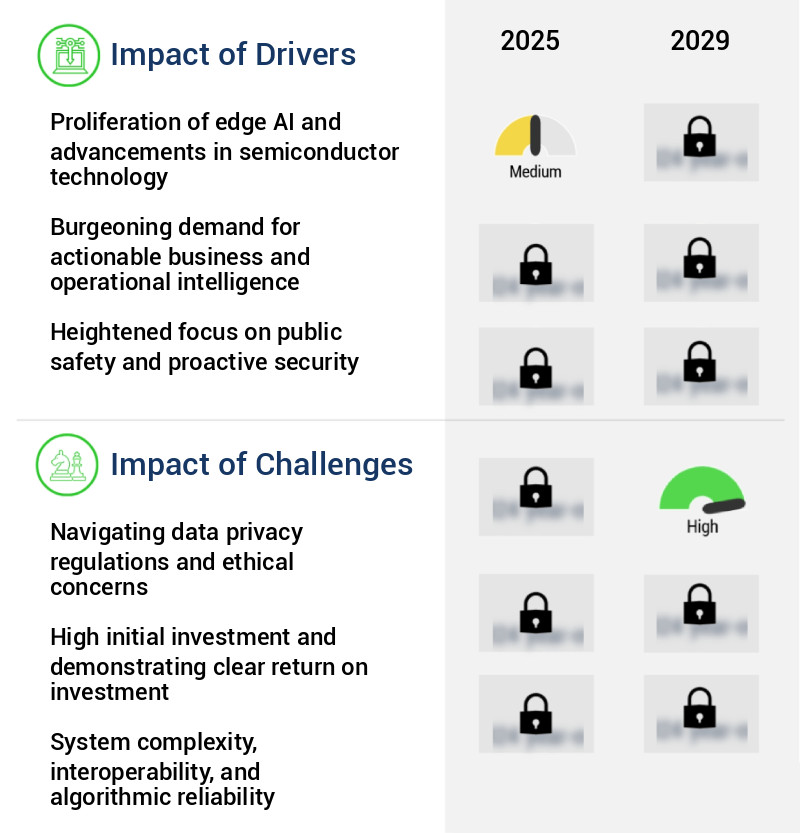
What are the key market drivers leading to the rise in the adoption of AI Camera Industry?
- The proliferation of edge AI and significant advancements in semiconductor technology are the primary factors fueling market growth.
- The market is experiencing significant growth due to the rapid advancement and democratization of edge computing. This evolution is driven by the increasing power and energy efficiency of semiconductor technology, enabling artificial intelligence processing directly on the camera itself. This on-device processing, facilitated by specialized hardware like System on a Chip (SoC) designs with integrated Neural Processing Units (NPUs), offers substantial benefits. It significantly reduces latency by eliminating the need for data transmission to the cloud, allowing for instantaneous alerts and responses essential for security and safety applications.
- The integration of AI capabilities into cameras is revolutionizing industries such as healthcare, transportation, and manufacturing, enhancing efficiency, safety, and productivity. The integration of AI into cameras is a game-changer, transforming how data is collected, analyzed, and acted upon in real-time.
What are the market trends shaping the AI Camera Industry?
- The integration of generative AI for natural language video interrogation is becoming a prominent market trend. This advanced technology is poised to revolutionize the way we interact with multimedia content.
- The market is undergoing a significant transformation, with the integration of generative artificial intelligence (AI) and large language models (LLMs) becoming a prominent trend. Traditionally, accessing video data involved laborious manual searches or structured queries based on predefined metadata tags. However, the current trend shifts towards a conversational, natural language interface. This evolution enables operators, regardless of their technical background, to interact with extensive video archives by posing queries in plain language.
- The AI system deciphers the query's meaning and context, translating it into a sophisticated search across video streams to retrieve the pertinent clips. This trend signifies a substantial leap forward in video data management, offering improved efficiency and accessibility.
What challenges does the AI Camera Industry face during its growth?
- Complying with data privacy regulations and addressing ethical concerns are essential tasks that significantly impact the growth of the industry. These challenges necessitate a deep understanding of applicable laws and ethical principles to ensure business success while maintaining trust with stakeholders.
- The market is experiencing significant evolution, integrating advanced technologies such as facial recognition and behavioral analysis. These capabilities, while offering numerous benefits across industries like retail, healthcare, and security, also raise concerns regarding data privacy and ethical use. The European Union's General Data Protection Regulation (GDPR) and the upcoming AI Act aim to address these issues, creating a complex regulatory landscape.
Exclusive Technavio Analysis on Customer Landscape
The ai camera market forecasting report includes the adoption lifecycle of the market, covering from the innovator's stage to the laggard's stage. It focuses on adoption rates in different regions based on penetration. Furthermore, the ai camera market report also includes key purchase criteria and drivers of price sensitivity to help companies evaluate and develop their market growth analysis strategies.
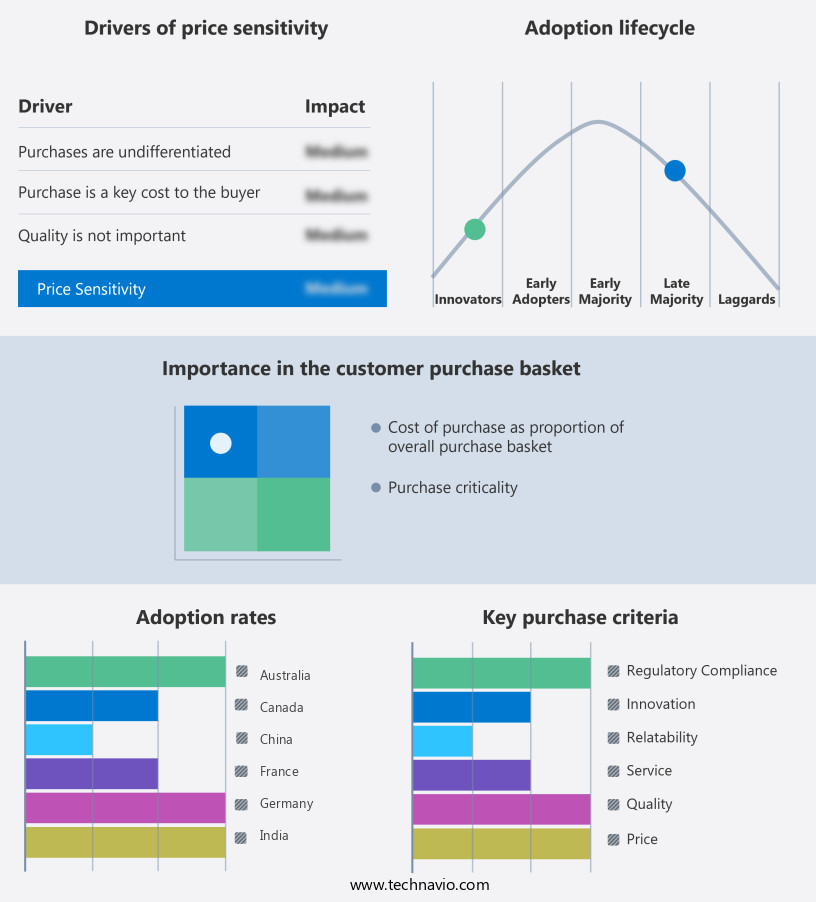
Customer Landscape of AI Camera Industry
Competitive Landscape
Companies are implementing various strategies, such as strategic alliances, ai camera market forecast, partnerships, mergers and acquisitions, geographical expansion, and product/service launches, to enhance their presence in the industry.
Apple Inc. - The company showcases advanced AI integration in their latest camera models, such as the iPhone 16 Pro, enhancing photographic capabilities with intelligent features for superior image quality.
The industry research and growth report includes detailed analyses of the competitive landscape of the market and information about key companies, including:
- Apple Inc.
- Avigilon Corp.
- Axis Communications AB
- Bosch Sicherheitssysteme GmbH
- Canon Inc.
- Dahua Technology Co. Ltd.
- Eagle Eye Networks Inc.
- Google LLC
- Hangzhou Hikvision Digital Technology Co. Ltd.
- Honeywell International Inc.
- Huawei Technologies Co. Ltd.
- Merit LILIN Ent. Co. Ltd.
- Panasonic Holdings Corp.
- Reolink
- Samsung Electronics Co. Ltd.
- Sony Group Corp.
- Teledyne FLIR LLC
- Tiandy Technologies Co. Ltd.
- VIVOTEK Inc.
- Zhejiang Uniview Technologies Co. Ltd.
Qualitative and quantitative analysis of companies has been conducted to help clients understand the wider business environment as well as the strengths and weaknesses of key industry players. Data is qualitatively analyzed to categorize companies as pure play, category-focused, industry-focused, and diversified; it is quantitatively analyzed to categorize companies as dominant, leading, strong, tentative, and weak.
Recent Development and News in AI Camera Market
- In January 2024, Google announced the launch of its new Google Nest Cam with built-in Google Tensor chip and AI capabilities, enabling advanced object recognition and real-time alerts (Google Press Release).
- In March 2024, Sony and Microsoft entered into a strategic partnership to integrate Sony's AI-powered image sensors into Microsoft's Azure IoT platform, aiming to enhance security and surveillance solutions (Microsoft News Center).
- In April 2025, Hikvision, a leading manufacturer of security cameras, raised USD1.5 billion in an IPO on the Hong Kong Stock Exchange, marking the largest tech IPO in the city since 2018 (Reuters).
- In May 2025, the European Union passed the Artificial Intelligence Act, setting regulations for the use of AI in various sectors, including the camera industry, to ensure ethical and transparent use of AI technology (European Commission Press Release).
Dive into Technavio's robust research methodology, blending expert interviews, extensive data synthesis, and validated models for unparalleled AI Camera Market insights. See full methodology.
|
Market Scope
|
|
Report Coverage
|
Details
|
|
Page number
|
250
|
|
Base year
|
2024
|
|
Historic period
|
2019-2023 |
|
Forecast period
|
2025-2029
|
|
Growth momentum & CAGR
|
Accelerate at a CAGR of 24.9%
|
|
Market growth 2025-2029
|
USD 19014.2 million
|
|
Market structure
|
Fragmented
|
|
YoY growth 2024-2025(%)
|
23.4
|
|
Key countries
|
US, China, India, Germany, Japan, Canada, UK, France, South Korea, and Australia
|
|
Competitive landscape
|
Leading Companies, Market Positioning of Companies, Competitive Strategies, and Industry Risks
|
Request Free Sample
Research Analyst Overview
- The market continues to evolve, driven by advancements in computer vision algorithms and machine learning pipelines. Object tracking algorithms and pose estimation techniques enhance surveillance systems, while image enhancement filters and optical character recognition improve efficiency in industries such as logistics and manufacturing. Sensor fusion techniques, convolutional neural networks, and motion detection algorithms expand the capabilities of security and autonomous vehicles. Facial recognition systems and deep learning frameworks enable advanced access control and identification applications. Image segmentation methods and machine learning pipelines optimize quality control in agriculture and manufacturing. Thermal imaging cameras and camera calibration methods offer new possibilities in healthcare and environmental monitoring.
- Video analytics platforms and visual slam systems revolutionize indoor navigation and augmented reality experiences. AI model optimization, hardware acceleration impact, and power efficiency metrics are crucial considerations for the widespread adoption of AI cameras. Industry growth is expected to reach 15% annually, with companies investing in deep learning frameworks, model inference latency reduction, and real-time processing speed. For instance, a leading retailer implemented an AI camera system with object detection models and image recognition accuracy of 98%. This resulted in a 20% increase in sales through improved inventory management and customer experience. The future of AI cameras lies in edge computing deployment, training dataset size expansion, and the integration of depth sensing technology, such as lidar and sonar, with hyper spectral cameras.
What are the Key Data Covered in this AI Camera Market Research and Growth Report?
-
What is the expected growth of the AI Camera Market between 2025 and 2029?
-
What segmentation does the market report cover?
-
The report is segmented by Product Type (Surveillance cameras, Smartphone cameras, DSLR cameras, and Others), Technology (Image and face recognition, Computer vision, Context awareness, Voice and speech recognition, and Others), End-user (Consumer electronics, Surveillance and public safety, Automotive, Retail, and Others), and Geography (North America, APAC, Europe, Middle East and Africa, and South America)
-
Which regions are analyzed in the report?
-
North America, APAC, Europe, Middle East and Africa, and South America
-
What are the key growth drivers and market challenges?
-
Who are the major players in the AI Camera Market?
-
Apple Inc., Avigilon Corp., Axis Communications AB, Bosch Sicherheitssysteme GmbH, Canon Inc., Dahua Technology Co. Ltd., Eagle Eye Networks Inc., Google LLC, Hangzhou Hikvision Digital Technology Co. Ltd., Honeywell International Inc., Huawei Technologies Co. Ltd., Merit LILIN Ent. Co. Ltd., Panasonic Holdings Corp., Reolink, Samsung Electronics Co. Ltd., Sony Group Corp., Teledyne FLIR LLC, Tiandy Technologies Co. Ltd., VIVOTEK Inc., and Zhejiang Uniview Technologies Co. Ltd.
Market Research Insights
- The market for AI cameras is a continuously evolving landscape, driven by advancements in computer vision and machine learning technologies. Two significant data points illustrate this growth. First, the global sales of AI cameras are projected to increase by 20% annually over the next five years. Second, a leading manufacturer reported a 15% increase in sales due to the integration of AI capabilities in their camera models. These advancements have led to improvements in object detection speed, false negative rate, and precision-recall curve performance.
- Furthermore, AI cameras are increasingly being adopted in various industries, including security and surveillance, manufacturing, and transportation, due to their ability to enhance operational efficiency and accuracy. Industry experts anticipate that this trend will continue as AI technologies become more sophisticated and cost-effective.
We can help! Our analysts can customize this ai camera market research report to meet your requirements.
Get in touch
1 Executive Summary
- 1.1 Market overview
- Executive Summary - Chart on Market Overview
- Executive Summary - Data Table on Market Overview
- Executive Summary - Chart on Global Market Characteristics
- Executive Summary - Chart on Market by Geography
- Executive Summary - Chart on Market Segmentation by Product Type
- Executive Summary - Chart on Market Segmentation by Technology
- Executive Summary - Chart on Market Segmentation by End-user
- Executive Summary - Chart on Incremental Growth
- Executive Summary - Data Table on Incremental Growth
- Executive Summary - Chart on Company Market Positioning
2 Technavio Analysis
- 2.1 Analysis of price sensitivity, lifecycle, customer purchase basket, adoption rates, and purchase criteria
- Analysis of price sensitivity, lifecycle, customer purchase basket, adoption rates, and purchase criteria
- 2.2 Criticality of inputs and Factors of differentiation
- Overview on criticality of inputs and factors of differentiation
- 2.3 Factors of disruption
- Overview on factors of disruption
- 2.4 Impact of drivers and challenges
- Impact of drivers and challenges in 2024 and 2029
3 Market Landscape
- 3.1 Market ecosystem
- Parent Market
- Data Table on - Parent Market
- 3.2 Market characteristics
- Market characteristics analysis
4 Market Sizing
- 4.1 Market definition
- Offerings of companies included in the market definition
- 4.2 Market segment analysis
- 4.4 Market outlook: Forecast for 2024-2029
- Chart on Global - Market size and forecast 2024-2029 ($ million)
- Data Table on Global - Market size and forecast 2024-2029 ($ million)
- Chart on Global Market: Year-over-year growth 2024-2029 (%)
- Data Table on Global Market: Year-over-year growth 2024-2029 (%)
5 Historic Market Size
- 5.1 Global AI Camera Market 2019 - 2023
- Historic Market Size - Data Table on Global AI Camera Market 2019 - 2023 ($ million)
- 5.2 Product Type segment analysis 2019 - 2023
- Historic Market Size - Product Type Segment 2019 - 2023 ($ million)
- 5.3 Technology segment analysis 2019 - 2023
- Historic Market Size - Technology Segment 2019 - 2023 ($ million)
- 5.4 End-user segment analysis 2019 - 2023
- Historic Market Size - End-user Segment 2019 - 2023 ($ million)
- 5.5 Geography segment analysis 2019 - 2023
- Historic Market Size - Geography Segment 2019 - 2023 ($ million)
- 5.6 Country segment analysis 2019 - 2023
- Historic Market Size - Country Segment 2019 - 2023 ($ million)
6 Five Forces Analysis
- 6.1 Five forces summary
- Five forces analysis - Comparison between 2024 and 2029
- 6.2 Bargaining power of buyers
- Bargaining power of buyers - Impact of key factors 2024 and 2029
- 6.3 Bargaining power of suppliers
- Bargaining power of suppliers - Impact of key factors in 2024 and 2029
- 6.4 Threat of new entrants
- Threat of new entrants - Impact of key factors in 2024 and 2029
- 6.5 Threat of substitutes
- Threat of substitutes - Impact of key factors in 2024 and 2029
- 6.6 Threat of rivalry
- Threat of rivalry - Impact of key factors in 2024 and 2029
- 6.7 Market condition
- Chart on Market condition - Five forces 2024 and 2029
7 Market Segmentation by Product Type
- 7.1 Market segments
- Chart on Product Type - Market share 2024-2029 (%)
- Data Table on Product Type - Market share 2024-2029 (%)
- 7.2 Comparison by Product Type
- Chart on Comparison by Product Type
- Data Table on Comparison by Product Type
- 7.3 Surveillance cameras - Market size and forecast 2024-2029
- Chart on Surveillance cameras - Market size and forecast 2024-2029 ($ million)
- Data Table on Surveillance cameras - Market size and forecast 2024-2029 ($ million)
- Chart on Surveillance cameras - Year-over-year growth 2024-2029 (%)
- Data Table on Surveillance cameras - Year-over-year growth 2024-2029 (%)
- 7.4 Smartphone cameras - Market size and forecast 2024-2029
- Chart on Smartphone cameras - Market size and forecast 2024-2029 ($ million)
- Data Table on Smartphone cameras - Market size and forecast 2024-2029 ($ million)
- Chart on Smartphone cameras - Year-over-year growth 2024-2029 (%)
- Data Table on Smartphone cameras - Year-over-year growth 2024-2029 (%)
- 7.5 DSLR cameras - Market size and forecast 2024-2029
- Chart on DSLR cameras - Market size and forecast 2024-2029 ($ million)
- Data Table on DSLR cameras - Market size and forecast 2024-2029 ($ million)
- Chart on DSLR cameras - Year-over-year growth 2024-2029 (%)
- Data Table on DSLR cameras - Year-over-year growth 2024-2029 (%)
- 7.6 Others - Market size and forecast 2024-2029
- Chart on Others - Market size and forecast 2024-2029 ($ million)
- Data Table on Others - Market size and forecast 2024-2029 ($ million)
- Chart on Others - Year-over-year growth 2024-2029 (%)
- Data Table on Others - Year-over-year growth 2024-2029 (%)
- 7.7 Market opportunity by Product Type
- Market opportunity by Product Type ($ million)
- Data Table on Market opportunity by Product Type ($ million)
8 Market Segmentation by Technology
- 8.1 Market segments
- Chart on Technology - Market share 2024-2029 (%)
- Data Table on Technology - Market share 2024-2029 (%)
- 8.2 Comparison by Technology
- Chart on Comparison by Technology
- Data Table on Comparison by Technology
- 8.3 Image and face recognition - Market size and forecast 2024-2029
- Chart on Image and face recognition - Market size and forecast 2024-2029 ($ million)
- Data Table on Image and face recognition - Market size and forecast 2024-2029 ($ million)
- Chart on Image and face recognition - Year-over-year growth 2024-2029 (%)
- Data Table on Image and face recognition - Year-over-year growth 2024-2029 (%)
- 8.4 Computer vision - Market size and forecast 2024-2029
- Chart on Computer vision - Market size and forecast 2024-2029 ($ million)
- Data Table on Computer vision - Market size and forecast 2024-2029 ($ million)
- Chart on Computer vision - Year-over-year growth 2024-2029 (%)
- Data Table on Computer vision - Year-over-year growth 2024-2029 (%)
- 8.5 Context awareness - Market size and forecast 2024-2029
- Chart on Context awareness - Market size and forecast 2024-2029 ($ million)
- Data Table on Context awareness - Market size and forecast 2024-2029 ($ million)
- Chart on Context awareness - Year-over-year growth 2024-2029 (%)
- Data Table on Context awareness - Year-over-year growth 2024-2029 (%)
- 8.6 Voice and speech recognition - Market size and forecast 2024-2029
- Chart on Voice and speech recognition - Market size and forecast 2024-2029 ($ million)
- Data Table on Voice and speech recognition - Market size and forecast 2024-2029 ($ million)
- Chart on Voice and speech recognition - Year-over-year growth 2024-2029 (%)
- Data Table on Voice and speech recognition - Year-over-year growth 2024-2029 (%)
- 8.7 Others - Market size and forecast 2024-2029
- Chart on Others - Market size and forecast 2024-2029 ($ million)
- Data Table on Others - Market size and forecast 2024-2029 ($ million)
- Chart on Others - Year-over-year growth 2024-2029 (%)
- Data Table on Others - Year-over-year growth 2024-2029 (%)
- 8.8 Market opportunity by Technology
- Market opportunity by Technology ($ million)
- Data Table on Market opportunity by Technology ($ million)
9 Market Segmentation by End-user
- 9.1 Market segments
- Chart on End-user - Market share 2024-2029 (%)
- Data Table on End-user - Market share 2024-2029 (%)
- 9.2 Comparison by End-user
- Chart on Comparison by End-user
- Data Table on Comparison by End-user
- 9.3 Consumer electronics - Market size and forecast 2024-2029
- Chart on Consumer electronics - Market size and forecast 2024-2029 ($ million)
- Data Table on Consumer electronics - Market size and forecast 2024-2029 ($ million)
- Chart on Consumer electronics - Year-over-year growth 2024-2029 (%)
- Data Table on Consumer electronics - Year-over-year growth 2024-2029 (%)
- 9.4 Surveillance and public safety - Market size and forecast 2024-2029
- Chart on Surveillance and public safety - Market size and forecast 2024-2029 ($ million)
- Data Table on Surveillance and public safety - Market size and forecast 2024-2029 ($ million)
- Chart on Surveillance and public safety - Year-over-year growth 2024-2029 (%)
- Data Table on Surveillance and public safety - Year-over-year growth 2024-2029 (%)
- 9.5 Automotive - Market size and forecast 2024-2029
- Chart on Automotive - Market size and forecast 2024-2029 ($ million)
- Data Table on Automotive - Market size and forecast 2024-2029 ($ million)
- Chart on Automotive - Year-over-year growth 2024-2029 (%)
- Data Table on Automotive - Year-over-year growth 2024-2029 (%)
- 9.6 Retail - Market size and forecast 2024-2029
- Chart on Retail - Market size and forecast 2024-2029 ($ million)
- Data Table on Retail - Market size and forecast 2024-2029 ($ million)
- Chart on Retail - Year-over-year growth 2024-2029 (%)
- Data Table on Retail - Year-over-year growth 2024-2029 (%)
- 9.7 Others - Market size and forecast 2024-2029
- Chart on Others - Market size and forecast 2024-2029 ($ million)
- Data Table on Others - Market size and forecast 2024-2029 ($ million)
- Chart on Others - Year-over-year growth 2024-2029 (%)
- Data Table on Others - Year-over-year growth 2024-2029 (%)
- 9.8 Market opportunity by End-user
- Market opportunity by End-user ($ million)
- Data Table on Market opportunity by End-user ($ million)
10 Customer Landscape
- 10.1 Customer landscape overview
- Analysis of price sensitivity, lifecycle, customer purchase basket, adoption rates, and purchase criteria
11 Geographic Landscape
- 11.1 Geographic segmentation
- Chart on Market share by geography 2024-2029 (%)
- Data Table on Market share by geography 2024-2029 (%)
- 11.2 Geographic comparison
- Chart on Geographic comparison
- Data Table on Geographic comparison
- 11.3 North America - Market size and forecast 2024-2029
- Chart on North America - Market size and forecast 2024-2029 ($ million)
- Data Table on North America - Market size and forecast 2024-2029 ($ million)
- Chart on North America - Year-over-year growth 2024-2029 (%)
- Data Table on North America - Year-over-year growth 2024-2029 (%)
- 11.4 APAC - Market size and forecast 2024-2029
- Chart on APAC - Market size and forecast 2024-2029 ($ million)
- Data Table on APAC - Market size and forecast 2024-2029 ($ million)
- Chart on APAC - Year-over-year growth 2024-2029 (%)
- Data Table on APAC - Year-over-year growth 2024-2029 (%)
- 11.5 Europe - Market size and forecast 2024-2029
- Chart on Europe - Market size and forecast 2024-2029 ($ million)
- Data Table on Europe - Market size and forecast 2024-2029 ($ million)
- Chart on Europe - Year-over-year growth 2024-2029 (%)
- Data Table on Europe - Year-over-year growth 2024-2029 (%)
- 11.6 Middle East and Africa - Market size and forecast 2024-2029
- Chart on Middle East and Africa - Market size and forecast 2024-2029 ($ million)
- Data Table on Middle East and Africa - Market size and forecast 2024-2029 ($ million)
- Chart on Middle East and Africa - Year-over-year growth 2024-2029 (%)
- Data Table on Middle East and Africa - Year-over-year growth 2024-2029 (%)
- 11.7 South America - Market size and forecast 2024-2029
- Chart on South America - Market size and forecast 2024-2029 ($ million)
- Data Table on South America - Market size and forecast 2024-2029 ($ million)
- Chart on South America - Year-over-year growth 2024-2029 (%)
- Data Table on South America - Year-over-year growth 2024-2029 (%)
- 11.8 US - Market size and forecast 2024-2029
- Chart on US - Market size and forecast 2024-2029 ($ million)
- Data Table on US - Market size and forecast 2024-2029 ($ million)
- Chart on US - Year-over-year growth 2024-2029 (%)
- Data Table on US - Year-over-year growth 2024-2029 (%)
- 11.9 China - Market size and forecast 2024-2029
- Chart on China - Market size and forecast 2024-2029 ($ million)
- Data Table on China - Market size and forecast 2024-2029 ($ million)
- Chart on China - Year-over-year growth 2024-2029 (%)
- Data Table on China - Year-over-year growth 2024-2029 (%)
- 11.10 India - Market size and forecast 2024-2029
- Chart on India - Market size and forecast 2024-2029 ($ million)
- Data Table on India - Market size and forecast 2024-2029 ($ million)
- Chart on India - Year-over-year growth 2024-2029 (%)
- Data Table on India - Year-over-year growth 2024-2029 (%)
- 11.11 Germany - Market size and forecast 2024-2029
- Chart on Germany - Market size and forecast 2024-2029 ($ million)
- Data Table on Germany - Market size and forecast 2024-2029 ($ million)
- Chart on Germany - Year-over-year growth 2024-2029 (%)
- Data Table on Germany - Year-over-year growth 2024-2029 (%)
- 11.12 Japan - Market size and forecast 2024-2029
- Chart on Japan - Market size and forecast 2024-2029 ($ million)
- Data Table on Japan - Market size and forecast 2024-2029 ($ million)
- Chart on Japan - Year-over-year growth 2024-2029 (%)
- Data Table on Japan - Year-over-year growth 2024-2029 (%)
- 11.13 Canada - Market size and forecast 2024-2029
- Chart on Canada - Market size and forecast 2024-2029 ($ million)
- Data Table on Canada - Market size and forecast 2024-2029 ($ million)
- Chart on Canada - Year-over-year growth 2024-2029 (%)
- Data Table on Canada - Year-over-year growth 2024-2029 (%)
- 11.14 UK - Market size and forecast 2024-2029
- Chart on UK - Market size and forecast 2024-2029 ($ million)
- Data Table on UK - Market size and forecast 2024-2029 ($ million)
- Chart on UK - Year-over-year growth 2024-2029 (%)
- Data Table on UK - Year-over-year growth 2024-2029 (%)
- 11.15 France - Market size and forecast 2024-2029
- Chart on France - Market size and forecast 2024-2029 ($ million)
- Data Table on France - Market size and forecast 2024-2029 ($ million)
- Chart on France - Year-over-year growth 2024-2029 (%)
- Data Table on France - Year-over-year growth 2024-2029 (%)
- 11.16 South Korea - Market size and forecast 2024-2029
- Chart on South Korea - Market size and forecast 2024-2029 ($ million)
- Data Table on South Korea - Market size and forecast 2024-2029 ($ million)
- Chart on South Korea - Year-over-year growth 2024-2029 (%)
- Data Table on South Korea - Year-over-year growth 2024-2029 (%)
- 11.17 Australia - Market size and forecast 2024-2029
- Chart on Australia - Market size and forecast 2024-2029 ($ million)
- Data Table on Australia - Market size and forecast 2024-2029 ($ million)
- Chart on Australia - Year-over-year growth 2024-2029 (%)
- Data Table on Australia - Year-over-year growth 2024-2029 (%)
- 11.18 Market opportunity by geography
- Market opportunity by geography ($ million)
- Data Tables on Market opportunity by geography ($ million)
12 Drivers, Challenges, and Opportunity/Restraints
- 12.3 Impact of drivers and challenges
- Impact of drivers and challenges in 2024 and 2029
- 12.4 Market opportunities/restraints
13 Competitive Landscape
- 13.2 Competitive Landscape
- Overview on criticality of inputs and factors of differentiation
- 13.3 Landscape disruption
- Overview on factors of disruption
- 13.4 Industry risks
- Impact of key risks on business
14 Competitive Analysis
- 14.2 Company ranking index
- 14.3 Market positioning of companies
- Matrix on companies position and classification
- 14.4 Apple Inc.
- Apple Inc. - Overview
- Apple Inc. - Business segments
- Apple Inc. - Key news
- Apple Inc. - Key offerings
- Apple Inc. - Segment focus
- SWOT
- 14.5 Avigilon Corp.
- Avigilon Corp. - Overview
- Avigilon Corp. - Product / Service
- Avigilon Corp. - Key offerings
- SWOT
- 14.6 Axis Communications AB
- Axis Communications AB - Overview
- Axis Communications AB - Product / Service
- Axis Communications AB - Key news
- Axis Communications AB - Key offerings
- SWOT
- 14.7 Bosch Sicherheitssysteme GmbH
- Bosch Sicherheitssysteme GmbH - Overview
- Bosch Sicherheitssysteme GmbH - Product / Service
- Bosch Sicherheitssysteme GmbH - Key offerings
- SWOT
- 14.8 Canon Inc.
- Canon Inc. - Overview
- Canon Inc. - Business segments
- Canon Inc. - Key news
- Canon Inc. - Key offerings
- Canon Inc. - Segment focus
- SWOT
- 14.9 Dahua Technology Co. Ltd.
- Dahua Technology Co. Ltd. - Overview
- Dahua Technology Co. Ltd. - Product / Service
- Dahua Technology Co. Ltd. - Key offerings
- SWOT
- 14.10 Google LLC
- Google LLC - Overview
- Google LLC - Product / Service
- Google LLC - Key offerings
- SWOT
- 14.11 Hangzhou Hikvision Digital Technology Co. Ltd.
- Hangzhou Hikvision Digital Technology Co. Ltd. - Overview
- Hangzhou Hikvision Digital Technology Co. Ltd. - Product / Service
- Hangzhou Hikvision Digital Technology Co. Ltd. - Key news
- Hangzhou Hikvision Digital Technology Co. Ltd. - Key offerings
- SWOT
- 14.12 Honeywell International Inc.
- Honeywell International Inc. - Overview
- Honeywell International Inc. - Business segments
- Honeywell International Inc. - Key news
- Honeywell International Inc. - Key offerings
- Honeywell International Inc. - Segment focus
- SWOT
- 14.13 Huawei Technologies Co. Ltd.
- Huawei Technologies Co. Ltd. - Overview
- Huawei Technologies Co. Ltd. - Product / Service
- Huawei Technologies Co. Ltd. - Key news
- Huawei Technologies Co. Ltd. - Key offerings
- SWOT
- 14.14 Samsung Electronics Co. Ltd.
- Samsung Electronics Co. Ltd. - Overview
- Samsung Electronics Co. Ltd. - Business segments
- Samsung Electronics Co. Ltd. - Key news
- Samsung Electronics Co. Ltd. - Key offerings
- Samsung Electronics Co. Ltd. - Segment focus
- SWOT
- 14.15 Sony Group Corp.
- Sony Group Corp. - Overview
- Sony Group Corp. - Business segments
- Sony Group Corp. - Key offerings
- Sony Group Corp. - Segment focus
- SWOT
- 14.16 Teledyne FLIR LLC
- Teledyne FLIR LLC - Overview
- Teledyne FLIR LLC - Product / Service
- Teledyne FLIR LLC - Key offerings
- SWOT
- 14.17 VIVOTEK Inc.
- VIVOTEK Inc. - Overview
- VIVOTEK Inc. - Product / Service
- VIVOTEK Inc. - Key offerings
- SWOT
- 14.18 Zhejiang Uniview Technologies Co. Ltd.
- Zhejiang Uniview Technologies Co. Ltd. - Overview
- Zhejiang Uniview Technologies Co. Ltd. - Product / Service
- Zhejiang Uniview Technologies Co. Ltd. - Key offerings
- SWOT
15 Appendix
- 15.2 Inclusions and exclusions checklist
- Inclusions checklist
- Exclusions checklist
- 15.3 Currency conversion rates for US$
- Currency conversion rates for US$
- 15.4 Research methodology
- 15.7 Validation techniques employed for market sizing
- Validation techniques employed for market sizing
- 15.9 360 degree market analysis
- 360 degree market analysis
- 15.10 List of abbreviations







![]() Get the report (PDF) sent to your email within minutes.
Get the report (PDF) sent to your email within minutes.
Complimentary full Excel data with your report purchase.